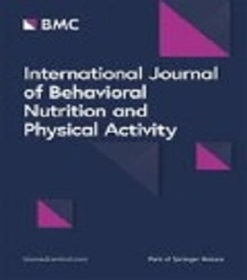2003-2010年和2015-2018年美国国家健康与营养调查(NHANES)中每日进食频率和夜间禁食时间与生物衰老的关系
IF 5.6
1区 医学
Q1 NUTRITION & DIETETICS
International Journal of Behavioral Nutrition and Physical Activity
Pub Date : 2024-09-19
DOI:10.1186/s12966-024-01654-y
引用次数: 0
摘要
有关每日进食频率(DEF)和夜间禁食时间(NFD)对生物衰老的影响的信息极少。我们的研究调查了 DEF 和 NFD 与加速衰老的潜在关联。在 NHANES 2003-2010 年和 2015-2018 年的 24212 名参与者中,根据 12 项血液化学参数计算了 4 项预测年龄指标[稳态失调 (HD)、Klemera-Doubal 法 (KDM)、phenoAge (PA) 和异位负荷 (AL)]。利用 24 小时饮食回忆,DEF 通过进食频率进行测量,而 NFD 则通过评估一天中最初和最后一餐的进食时间来确定。利用加权多元线性回归模型和限制性立方样条曲线(RCS)来检验两者之间的关联。与DEF≤3.0倍的受试者相比,DEF≥4.6倍的受试者的KDM残差[β:-0.57,95%置信区间(CI):(-0.97,-0.17)]和PA残差[β:-0.47,95%置信区间(CI):(-0.69,-0.25)]更低。与 10.1 至 12.0 小时的 NFD 相比,NFD ≤ 10.0 小时的个体的 HD [β:0.03,95% CI:(0.01,0.04)]、KDM 残差[β:0.34,95% CI:(0.05,0.63)]和 PA 残差[β:0.38,95% CI:(0.18,0.57)]更高。同样,NFD ≥ 14.1 小时者的 HD [β:0.02,95% CI:(0.01,0.04)] 和 KDM 残留 [β:0.33,95% CI:(0.03,0.62)] 也较高。DEF 和 NFD 与预测年龄指标的剂量反应关系证实了上述结果。乳酸脱氢酶(LDH)和球蛋白(Glo)被认为参与并介导了这些关系。DEF 低于 3.0 倍、NFD 小于 10.0 或大于 14.1 小时与较高的预测年龄指标独立相关。本文章由计算机程序翻译,如有差异,请以英文原文为准。
Associations of daily eating frequency and nighttime fasting duration with biological aging in National Health and Nutrition Examination Survey (NHANES) 2003–2010 and 2015–2018
Information on the influences of daily eating frequency (DEF) and nighttime fasting duration (NFD) on biological aging is minimal. Our study investigated the potential associations of DEF and NFD with accelerated aging. Out of 24212 participants in NHANES 2003–2010 and 2015–2018, 4 predicted age metrics [homeostatic dysregulation (HD), Klemera–Doubal method (KDM), phenoAge (PA), and allostatic load (AL)] were computed based on 12 blood chemistry parameters. Utilizing 24-h dietary recall, DEF was measured by the frequency of eating occurrences, while NFD was determined by assessing the timing of the initial and final meals throughout the day. Weighted multivariate linear regression models and restricted cubic spline (RCS) were utilized to examine the associations. Compared to DEF of ≤ 3.0 times, subjects with DEF ≥ 4.6 times demonstrated lower KDM residual [β: -0.57, 95% confidence-interval (CI): (-0.97, -0.17)] and PA residual [β: -0.47, 95% CI: (-0.69, -0.25)]. In comparison to NFD between 10.1 and 12.0 h, individuals with NFD ≤ 10.0 h were at higher HD [β: 0.03, 95% CI: (0.01, 0.04)], KDM residual [β: 0.34, 95% CI: (0.05, 0.63)], and PA residual [β: 0.38, 95% CI: (0.18, 0.57)]. Likewise, those with NFD ≥ 14.1 h also had higher HD [β: 0.02, 95% CI: (0.01, 0.04)] and KDM residual [β: 0.33, 95% CI: (0.03, 0.62)]. The results were confirmed by the dose–response relationships of DEF and NFD with predicted age metrics. Lactate dehydrogenase (LDH) and globulin (Glo) were acknowledged as implicated in and mediating the relationships. DEF below 3.0 times and NFD less than 10.0 or more than 14.1 h were independently associated with higher predicted age metrics.
求助全文
通过发布文献求助,成功后即可免费获取论文全文。
去求助
来源期刊
CiteScore
13.80
自引率
3.40%
发文量
138
审稿时长
4-8 weeks
期刊介绍:
International Journal of Behavioral Nutrition and Physical Activity (IJBNPA) is an open access, peer-reviewed journal offering high quality articles, rapid publication and wide diffusion in the public domain.
IJBNPA is devoted to furthering the understanding of the behavioral aspects of diet and physical activity and is unique in its inclusion of multiple levels of analysis, including populations, groups and individuals and its inclusion of epidemiology, and behavioral, theoretical and measurement research areas.

 求助内容:
求助内容: 应助结果提醒方式:
应助结果提醒方式:


